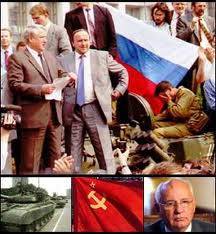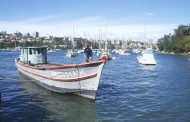The Fall of Communism in Russia

Fall of Communism
By the 1980s, it was pretty obvious that communism in USSR was not really working out. Mikhail Gorbachev became the leader of the USSR in 1985 and he introduced many reforms in an attempt to modernize the economy and make the Communist Party more democratic. All that this led to was the breakup of the USSR and the end of the one-party Communist rule, as well as the collapse of the well-known Iron Curtain and the end of the Communist rule.
Gorbachev and his Reforms
Gorbachev set out to introduce reforms after realising that the Russian economy was not only not growing, but was stagnating. Therefore he set out to introduce perestroika – economic and political restructuring, as well as glasnost – openness. He started off introducing changes in small ways, hoping to mdernize the economy so that it would grow at a modest rate of about 4% each year. All these, he set off to do without a proper plan, moulding the Communist economic and political structures. This, he conducted in 4 phases.
Phase 1
From 1985 to 1986, Gorbachew continued an anti-alcohol programme which his predecessor, Andropov, had started. The price of vodka was increased, the legal drinking age was raised from 18 to 21 and the hours of alcohol sales were reduced. He hoped this would discourage workers from drinking and thus improve the productivity of workers and in turn increase industrial output. This campaign was very unpopular and it failed.
Phase 2
During this period, he introduced more fundamental and drastic changes. One of these was the Law of State Enterprises set in June 1987. This gave businesses much more independence from the governement or state ministries that controlled them in the past. Despite the increased independence, there was still some state control over their activities. As this was quite a radical change and was seen as a move away from the old system of a centrally planned command economy, many people opposed to it. Workers were also encouraged to be more open, which was part of glasnost, and speak out against corruption or give suggestions. They were also encouraged to form small privately owned cooperatives such as grocery shops and hairdressing salons. All these, and more changes that made state enterprises less state-governed and more open, received much resistance from the ‘old guard’, which were the Communist Party and government officials. Therefore, he announced some steps towards democracy within the Communist Party, making the selection an election from a choice of candidates.
Phase 3
This time round, Gorbachev decided to change the structure of the government such that he would be able to execute his reforms without the sabotage and blockage from top party and state officials. In this phase, he introduced a new political institution, the Congress of People’s Deputies. This replaced the old parliament. This new institution was meant to be elected by the people and the institution was to elect a smaller institution named the Supreme Soviet in which the members had the power to make laws. Therefore, after he was named President of the USSR by the CPD, he could act without fear of being restrained by the Communist Party. He then proceeded to reduce the amount of influence the Communist had on the governement, thus reducing their hold on the government. He also introduced more reforms such that the economic and political systems of the country could be opened up.
Phase 4
In this last and final phase, was the downfall of Gorbachev as well as perestroika. This was due to Gorbachev’s uncertainty due to resistance from hardliners and encouragement from extremists. This caused him to be uncertain, resulting in him not really following any consistent policies. Thus, after a coup attempted to remove him from power, he had very little political support and was almost powerless as Boris Yeltsin became president.Therefore, it can be seen that perestroika was indeed a failure. Meanwhile, due to it as well as glasnost, Russia was more independant of the Communist Party and their iron grip on the government and the people. This would eventually lead to the downfall of Communism as well as the Iron Curtain.
The results of Gorbachev’s reforms
Gorbachev’s reforms, despite the aim of aiding economic improvement, actually caused an economic downfall, resulting in a series of strikes. This was due to the fact that factories reduced the production of everyday consumer goods as they concentrate on more expensive goods, thus resulting in the lack of consumer goods. This resulted in the rise of the price for consumer goods. Thus, money became more useless. This resulted in more printing of money which resulted in inflation. This did not really solve the problem, but aggravated it instead. Thus, the nation was plunged into an economic crisis and food rationing had to be done. This caused great dissatisfaction among the people of Russia and strikes were conducted to protest against the government.
The re-emergence of Nationalism
Under glasnost, more republics within the USSR started to express their feelings towards being incorporated into the USSR during the World War 2 as a result of the Nazi-Soviet Pact of 1939. They resented this incorporation and during the period of glasnost, made it very apparent to the government. After a long period of being surpressed, these republics used this new freedom to push for greater control over their economies and the right to express their national identity.This was due to the fact that they were mistreated by the central government and their interests were ignored just because the central government has overall control over them. This fired their demands which got increasingly higher, like separation and full independence from the central government. This shaked the stability and unity of the USSR, which would eventually lead to the downfall of communism and the Iron Curtain.
The August Coup in 1991
By 1991, Gorbachev was prepared to negotiate a settlement in which the reupublics would belong to a new union, which would only be ruled by the central government in certain areas, while the member repulics would be responsible for other matters. However, many hardliners were horrified by this imminent break-up of the USSR. These were people who were already opposed to Gorbachev’s economic reforms, which had failed and worsened the economic situation. Therefore, on the 18th of August, these hardliners launched a coup to overthrow Gorbachevv, in which he was placed under house arrest and rule was taken over by an eight-member committee.However, Boris Yeltsin, who became President, comdemned the coup and called upon the Russian people to resist the plotters. His actions caused the people to resit the coup and the coup failed. By the time Gorbachev returned to Moscow, he had become increasingly powerless and Boris was the then most popular politician. Gorbachev then resigned, as the coup was another clearly unsuccessful result of his reform programme.
The Collapse of Communism in the USSR as well as in Eastern Europe(Iron Curtain)
By this time, most of the satellite states in Eastern Europe, through the influence of glasnost, became more open in their demands of freedom from communist governance in their republics. Many revolutions happened in 1989, most of them involved overthrowing the communist government and replacing it with republics. Thus, the hold the Communists had over Eastern Europe aka the Iron Curtain had become very weak. Eventually, as a result of perestroika and glasnost, Communism collapsed, not only in the USSR but also in Eastern Europe. In USSR, Yeltsin and the republican governement took steps to end the power of the Communist party in Russia by suspending and banning the party and seizing all their property. This symbolised the fall of Communism in Russia.
In December 1991, the republics met to discuss a new kind of relationship, which eventually saw the birth of CIS (Commonwealth of Independent States). The replacement of the USSR by the CIS symbolised the complete downfall of Communism in Russia as well as the fall of the Iron Curtain.











































